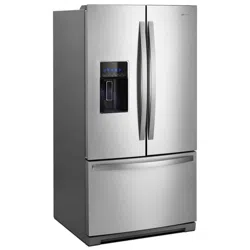Documents: Go to download!
- Owner's manual - (English)
- REFRIGERATOR SAFETY
- PARTS AND FEATURES
- INSTALLATION INSTRUCTIONS
- Unpack the Refrigerator
- INSTALLATION INSTRUCTIONS
- FILTERS AND ACCESSORIES
- Refrigerator Door(s) and Drawer
- Door Closing and Door Alignment
- Leveling and Door Closing
- Using the Controls
- Water Dispenser
- Water Filtration System
- REFRIGERATOR USE
- Cleaning
- Vacation and Moving Care
- FREEZER SHELF
- TROUBLESHOOTING .
- ITEMS WHIRLPOOL WILL NOT PAY FOR
Table of contents
User Guide Whirlpool WRF757SDHZ Refrigerator
REFRIGERATOR SAFETY
Proper Disposal of Your Old Refrigerator
IMPORTANT:
- Child entrapment and suffocation are not problems of the past. Junked or abandoned refrigerators are still dangerous—even if they will sit for “just a few days.”
- If you are getting rid of your old refrigerator, please follow these instructions to help prevent accidents.
Suffocation Hazard
- Remove doors from your old refrigerator.
- Failure to do so can result in death or brain damage.
- Before You Throw Away Your Old
Refrigerator or Freezer:
- Take off the doors.
- Leave the shelves in place so that children may not easily climb inside.
- Important information to know about disposal of refrigerants:
- Dispose of refrigerator in accordance with Federal and Local regulations. Refrigerants must be evacuated by a licensed,
- EPA certified refrigerant technician in accordance with established procedures.
PARTS AND FEATURES

Energy and Normal Operating Sounds
- Your new French Door Bottom Mount refrigerator has been designed to optimize energy efficiency, and better regulate temperatures to match cooling demand. You may notice that it operates differently from your previously owned refrigerator.
- It is normal for the high-efficiency compressor to run for extended periods of time at varying speeds in order to consume only the energy necessary for optimum efficiency. In addition, during various stages of the cooling cycle, you may hear normal operating sounds that are unfamiliar to you.
More Storage Space
- The French Door Bottom Mount has the most fresh food storage space available, including a full-width, temperature controlled, pantry drawer perfect for storing veggie trays or party platters.
In-Door-Ice® Ice Dispensing System
- The ice storage bin located in the door provides an entire extra shelf of storage space, and the storage bin is removable for easy access to filtered ice.
Dual Evaporator (on some models)
- The refrigerator and freezer compartments have dedicated evaporators to provide fresh and frozen foods with separate climates. Frozen food stays cold and dry, while fresh food remains at the ideal temperature and humidity.
Platter Pocket
- This full-width slide-out shelf tucked between the crispers and the lowest shelf is perfect for leftover family-sized casserole dishes, pizza boxes, and large party platters.
Water Filter
- NSF® Certified filter reduces chlorine taste and odor, particulates class I), lead, and mercury. Replacing the water filter every 6 months ensures clean, filtered drinking water.
Air Filter
- An air filter is 15 times more powerful than baking soda at reducing common food odors inside the refrigerator.
Produce Preserver (on some models)
- Ethylene is a natural gas produced by fruits and vegetables to promote ripening.
- The Produce Preserver absorbs ethylene, to delay the over-ripening of fresh produce. As a result, certain produce items will stay fresh longer.
CoolVox® Kitchen Sound System (on some models)
- We made the kitchen pulse with energy by adding music where it’s never been before. The CoolVox® kitchen sound system pairs easily with smart phones, tablets or other Bluetooth®† mobile devices.
INSTALLATION INSTRUCTIONS
Remove the Packaging
- Remove tape and glue residue from surfaces before turning on the refrigerator. Rub a small amount of liquid dish soap over the adhesive with your fingers. Wipe with warm water and dry.
- Do not use sharp instruments, rubbing alcohol, flammable fluids, or abrasive cleaners to remove tape or glue. These products can damage the surface of your refrigerator. For more information, see “Refrigerator Safety.”
- Dispose of/recycle all packaging materials.
Clean Before Using
- After you remove all of the package materials, clean the inside of your refrigerator before using it. See the cleaning instructions in
- Refrigerator Care.”
Recommended Grounding Method
- A 115 Volt, 60 Hz, AC only 15 or 20 A fused, grounded electrical supply is required.
- It is recommended that a separate circuit serving only your refrigerator be provided. Use an outlet that cannot be turned off by a switch. Do not use an extension cord

NOTE:
- Before performing any type of installation, cleaning, or removing a light bulb, turn the refrigerator to OFF.
- Depending on your model, either turn the freezer control to the word OFF, or press the Minus sign touch pads repeatedly until a dash (–) appears in both the Freezer and Refrigerator displays as shown. Disconnect the refrigerator from the electrical source.
- When you are finished, reconnect the refrigerator to the electrical source and reset the temperature controls to the desired setting. See “Using the Controls.”
Location Requirements

- To ensure proper ventilation for your refrigerator, allow for a minimum 1/2" (1.25 cm) of space on each side and at the top.
- Allow for a minimum 1" (2.54 cm) space behind the refrigerator.
- If your refrigerator has an ice maker, allow extra space at the back for the water line connections. When installing your refrigerator next to a fixed wall, leave a 3³⁄4" (9.5 cm) minimum space between the refrigerator and wall to allow the door to swing open.
NOTE:
- This refrigerator is intended for use in a location where the temperature ranges from a minimum of 55°F (13°C) to a maximum of 110°F (43°C). The preferred room temperature range for optimum performance, which reduces electricity usage and provides superior cooling, is between 60°F (15°C) and 90°F
- C). It is recommended that you do not install the refrigerator near a heat source such as an oven or radiator.
Remove and Replace Refrigerator Doors
- Measure the width of your door opening, to see whether or not you need to remove the refrigerator doors to move the refrigerator into your home. If door removal is necessary, see the following instructions.

IMPORTANT:
- If the refrigerator was previously installed and you are moving it out of the home, before you begin, turn the refrigerator control OFF. Unplug the refrigerator or disconnect power. Remove food and adjustable door or utility bins from doors.
- Gather the required tools and read all instructions before removing doors.
- TOOLS NEEDED: 3/16" hex key wrench and a #2 Phillips screwdriver
Remove Right-Hand Refrigerator Door
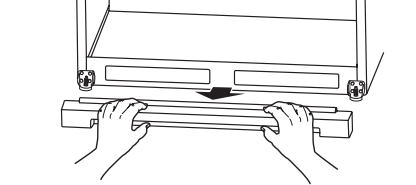
Unplug refrigerator or disconnect power.
- Keep the refrigerator doors closed until you are ready to lift them free from the cabinet.
NOTE:
- Provide additional support for the refrigerator door while the hinges are being removed. Do not depend on the door gasket magnets to hold the door in place while you are working.
- Using a Phillips screwdriver, remove the cover from the Top Hinge.
- Using the 3/16" hex key wrench, remove the two internal hex head screws from the top hinge, and set aside.
NOTE: Do not remove the two locator screws. These screws will help you align the hinge when you replace the door.
Remove Left-Hand Refrigerator Door
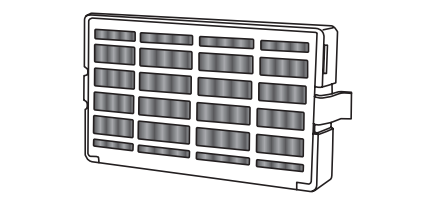
- The tubing and wiring for the water dispenser run through the left-hand door hinge, so they must be disconnected before removing the door.
- Using a Phillips screwdriver, remove the cover from the top hinge.
- Disconnect the water dispenser tubing located on top of the door hinge.
Style 1
- Press the outer ring against the face of the fitting and gently pull the dispenser tubing free.
NOTE:
- The water dispenser tubing remains attached to the left-hand refrigerator door.
Style 2
- Firmly pull up on the clasp. Then, pull the tubing out of the fitting.
NOTE:
- The water dispenser tubing remains attached to the left-hand refrigerator door.
- Disconnect the wiring plug located on top of the door hinge.
- Grasp each side of the wiring plug. With your left thumb, press down to release the catch and pull the sections of the plug apart.
NOTE:
- Do not remove the green, ground wire. It should remain attached to the door hinge.
- Using the 3/16" hex key wrench, remove the two internal hex head screws from the top hinge, and set aside.
NOTES:
- Provide additional support for the refrigerator door while the hinges are being removed. Do not depend on the door gasket magnets to hold the door in place while you are working.
- Do not remove the two locator screws. These screws will help you align the hinge when you replace the door.
- Lift the refrigerator door from the bottom hinge pin. The top hinge will come away with the door.
NOTE:
- It may not be necessary to remove the bottom hinges and brake feet assemblies to move the refrigerator through a doorway.
- Only if necessary, use a driver with a #2 square bit tip to remove the bottom hinges and a 3/8" nut driver to remove the brake feet screws.
Replace Right-Hand Refrigerator Door
- Set the right-hand door onto the bottom hinge pin.
- Insert the top hinge pin into the open hole in the top of the refrigerator door.
- Using the two 3/16" internal hex head screws, fasten the hinge to the cabinet. Do not tighten the screws completely.
- Replace Left-Hand Refrigerator Door
IMPORTANT:
- Do not intertwine the water tubing and wiring bundles when reconnecting them.
- Set the left-hand door onto the bottom hinge pin.
- Using the two 3/16" internal hex head screws, fasten the hinge to the cabinet. Do not tighten the screws completely.
Reconnect the water dispenser tubing.
Style 1 - Insert the tubing into the fitting until it stops and the outer ring is touching the face of fitting.
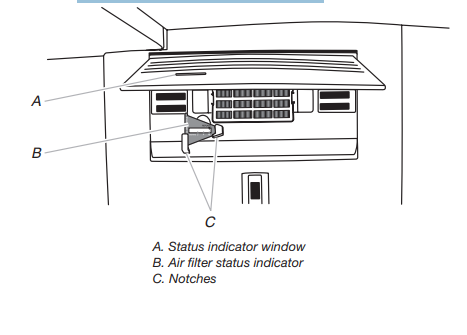
Style 2 - Insert the tubing firmly into the fitting until it stops.
- Close the clasp around the tubing. The clasp snaps into place between the fitting and the collar.
- Reconnect the electrical wiring.
- Push together the two sections of the wiring plug.
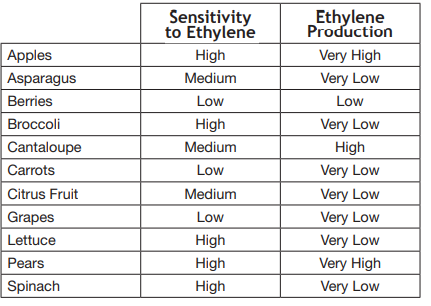
Final Steps
- Completely tighten the four internal hex head screws (two on the right-hand door hinge and two on the left-hand door hinge).
- Replace both top hinge covers.
- Remove Drawer Front
- Open the freezer drawer to its full extension.
- Remove the two screws at the top, inside the drawer front one on the left-hand side and one on the right-hand side) that fasten the drawer front to the drawer glides.
- Lift up on the drawer front to release the plastic studs from the drawer glide bracket slots.
- Slide the drawer glides back into the freezer.
Replace Drawer Front
- Pull out the freezer drawer glides to their full extension.
- Holding the drawer front by its sides, align the two plastic studs, located at the bottom, inside the drawer front, with the drawer glide bracket slots.
- NOTE: It helps if one person holds the drawer glides steady while another person aligns the drawer front and inserts the studs into the slots.
- Replace and tighten the two screws at the top of the drawer front (one on the left-hand side and one on the right-hand side).
Water Supply Requirements
- A cold water supply with water pressure between 35 and 120 psi and 827 kPa) is required to operate the water dispenser and ice maker. If you have questions about your water pressure, call a licensed, qualified plumber.
NOTE:
- If the water pressure is less than what is required, the flow of water from the water dispenser could decrease or ice cubes could be hollow or irregular shaped.
Reverse Osmosis Water Supply
- The pressure of the water supply coming out of a reverse osmosis system and supplying the water inlet valve of the refrigerator needs to be between 35 and 120 psi (241 and kPa).
- If a reverse osmosis water filtration system is connected to your home cold water supply, the water pressure to the reverse osmosis system needs to be a minimum of 40 to 60 psi (276 to kPa).
- Check to see whether the sediment filter in the reverse osmosis system is blocked. Replace the filter if necessary.
- Allow the storage tank on the reverse osmosis system to refill after heavy use. The tank capacity could be too small to keep up with the requirements of the refrigerator.
NOTE:
- Faucet-mounted reverse osmosis systems are not recommended.
- If your refrigerator has a water filter, it may further reduce the water pressure when used in conjunction with a reverse osmosis system. Remove the water filter. See the “Water
Filtration System” section.
- If you have questions about your water pressure, call a licensed, qualified plumber.
Connect the Water Supply
- Read all directions before you begin.
IMPORTANT:
- Connect to potable water supply only.
- Plumbing must be installed in accordance with the
- International Plumbing Code and any local codes and ordinances.
- The gray water tubing on the back of the refrigerator (which is used to connect to the household water line) is a PEX cross-linked polyethylene) tube. Copper and PEX tubing connections from the household water line to the refrigerator are acceptable, and will help avoid off-taste or odor in your ice or water. Check for leaks.
Remove the Handles
- While holding the handle, insert the short end of the hex key into a setscrew hole and slightly rotate the hex key until it is engaged in the setscrew.
- Using a right to left motion loosen the setscrew a quarter-turn at a time.
- Repeat steps 1 and 2 for the other setscrew. Slowly pull the handle away from the door or drawer.
- If necessary, use a Phillips screwdriver to remove the shoulder screws from the door.
To Steady the Refrigerator:
- Open the freezer drawer. Using a 1/4" hex driver, turn both brake feet clockwise the same amount until the brake feet are snug against the floor.
- Check again. If not satisfied, continue to adjust the brake feet by half turns of the screw until the refrigerator does not roll forward when the drawer is opened.
NOTE:
- Having someone push against the top of the refrigerator takes some weight off the brake feet. This makes it easier to turn the screws.
- Replace the base grille by aligning the ends of the grille with the leveling assemblies on each side and snapping the grille into place.
Unpack the Refrigerator
- Remove packing materials. Do not use sharp instruments. rubbing alcohol. flammable fluids. or abrasive cleaners to remove tape or glue. These products can damage the surface of your refrigerator. For more information. see “Refrigerator Safety.”
WARNING
- Suffocation Hazard
- Remove doors from your old refrigerator.
- Failure to do so can result in death or brain damage.
- Important information to know about disposal of refrigerants: Dispose of refrigerator in accordance with Federal and Local regulations. Refrigerants must be evacuated by a licensed.
Excessive Weight Hazard
- Use two or more people to move and install refrigerator.
- Failure to do so can result in back or other injury.
- When Moving Your Refrigerator: Your refrigerator is heavy. When moving the refrigerator for cleaning or service. be sure to cover the foor with cardboard or hardboard to avoid foor damage. Always pull the refrigerator straight out when moving it. Do not wiggle or “walk” the refrigerator when trying to move it. as foor damage could occur.
- Important information to know about glass shelves and covers: Do not clean glass shelves or covers with warm water when they are cold. Shelves and covers may break if exposed to sudden temperature changes or impact. such as bumping.
- Tempered glass is designed to shatter into many small. pebble-size pieces. This is normal. Glass shelves and covers are heavy. Use both hands when removing them to avoid dropping.
- Door Removal. Leveling. and Alignment
- Gather the required tools and parts and read all instructions before starting installation. Save these instructions for future reference.
NOTE:
- Before moving your product into your home. measure the doorway of your home to see whether you need to remove the refrigerator and freezer doors. If door removal is necessary. see the instructions below.
IMPORTANT:
- Before you begin. unplug refrigerator or disconnect power. Remove food. the ice storage bin (on some models). and any adjustable door or utility bins from doors.
INSTALLATION INSTRUCTIONS
Connect to Water Line
- If you have turned the refrigerator on before the water was connected, turn OFF the ice maker.
- Unplug refrigerator or disconnect power.
- Turn OFF main water supply. Turn ON nearest faucet long enough to reduce water pressure in the water line.
- Use a quarter-turn shut-off valve or the equivalent, served by a 1/2" (12.7 mm) household supply line.
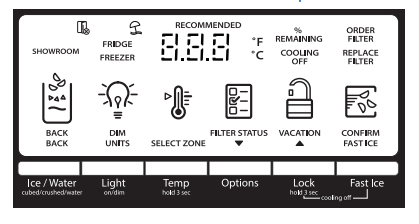
NOTE:
- To allow sufficient water flow to the refrigerator, a minimum mm) size household supply line is recommended.
- Now you are ready to connect the copper tubing to the shut-off valve. Use 1/4" (6.35 mm) O.D. (outside diameter) soft copper tubing to connect the shut-off valve and the refrigerator.
Style 1
- Remove plastic cap from water valve inlet port. Attach the copper tubing to the valve inlet using a compression nut and sleeve as shown
- Tighten the compression nut. Do not overtighten. Confirm copper tubing is secure by pulling on copper tubing.
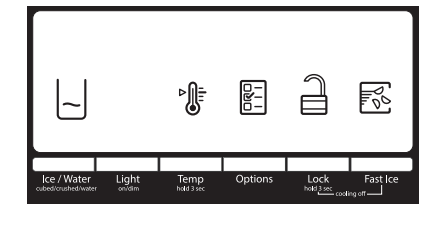
- Create a service loop with the copper tubing. Avoid kinks when coiling the copper tubing. Secure copper tubing to refrigerator cabinet with a “P” clamp.
Style 2
- Unplug refrigerator or disconnect power.
- Remove and discard the short, black plastic part from the end of the water line inlet.
- Thread the nut onto the end of the tubing. Tighten the nut by hand. Then tighten it with a wrench two more turns. Do not overtighten.

Install Handles
- Handle mounting setscrews are preinstalled inside the handle.
- Remove the handles from the packaging inside the refrigerator and place them on a soft surface.
- Open a refrigerator compartment door. On the closed door, place a handle onto the shoulder screws so that the setscrews are facing the adjacent door.
- Firmly push the handle toward the door until the handle base is flush against the door.
A. Household water line
B. Nut (purchased)
C. Ferrule (purchased)
D. Refrigerator water tubing
A. Shoulder screws
B. Setscrews inside the handle
INSTALLATION INSTRUCTIONS
- While holding the handle, insert the short end of the hex key into the upper hole and slightly rotate the hex key until it is engaged in the setscrew.
- Using a clockwise motion tighten the setscrew just until it begins to contact the shoulder screw. Do not fully tighten.
- Repeat steps 4 and 5 to fasten the lower setscrew.
- Once both setscrews have been partially tightened as instructed in the previous steps, fully tighten both setscrews.
IMPORTANT:
- When the screws feel tight, tighten them an additional quarter-turn. The handle is not properly installed without this extra tightening.
- Repeat steps 2 through 7 to install the other handle onto the adjacent refrigerator door.
- With the drawer(s) closed, place the handle onto the shoulder screws so that the setscrews are facing down toward the floor.
- Firmly push the handle toward the drawer until the handle base is flush against the drawer.
- Insert the short end of the hex key into the left-hand hole and slightly rotate the hex key until it is engaged in the setscrew.
- Using a left to right motion tighten the setscrew a quarter-turn at a time just until it begins to contact the shoulder screw. Do not fully tighten.
- Repeat steps 11 and 12 to fasten the right-hand setscrew to the shoulder screw.
- Once both setscrews have been partially tightened as instructed in the previous steps, fully tighten both setscrews.
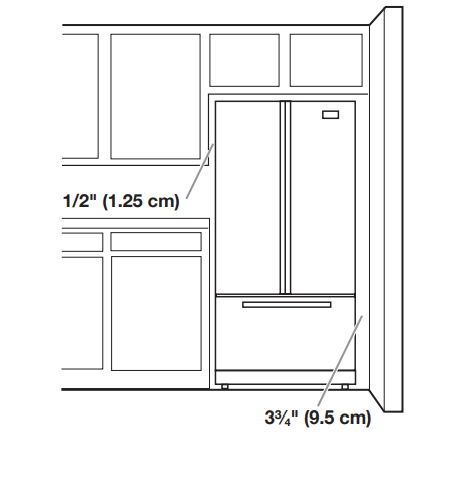
IMPORTANT
- When the screws feel tight, tighten them an additional quarter-turn. The handle is not properly installed without this extra tightening.
- For some models, repeat steps 9 through 14 to install a handle on the second drawer.
- Save the hex key and all instructions.
Move the refrigerator to its final location.
- Lower the brake feet, by turning them clockwise, until the rollers are off the floor and both brake feet are snug against the floor. This keeps the refrigerator from rolling forward when opening the refrigerator doors or freezer drawer.
IMPORTANT:
- If you need to make further adjustments involving the brake feet, you must turn both brake feet the same amount to keep the refrigerator level.
- Make sure the doors close easily. If you are satisfied with the door opening and closing, skip the next section and go to
- Align the Doors.” If, however, the doors do not close easily or the doors pop open, adjust the tilt.
To Adjust the Cabinet Tilt:
- Open the freezer drawer. Use a 1/4" hex driver to turn both brake feet clockwise the same amount. This will raise the front of the refrigerator. It may take several turns to allow the doors to close easier.
NOTE:
- Having someone push against the top of the refrigerator takes some weight off the brake feet. This makes it easier to turn them.
- Make sure the doors are even at the top and that the space between the bottom of the refrigerator doors and the top of the freezer drawer is even. If necessary, align the doors.
To Align the Doors:
- Keeping both refrigerator doors closed, pull out the freezer drawer. Locate the bottom hinge pin of the righthand refrigerator door. The alignment screw is inside the bottom hinge pin.
- Insert the short end of the 1/8" hex key wrench (packed with the Door Handle Installation Instructions) into the bottom hinge pin until it is fully engaged in the alignment screw.
- To raise the refrigerator door, turn the hex key to the right.
- To lower the door, turn the hex key to the left.
- Continue to turn the alignment screw until the doors are aligned.
FILTERS AND ACCESSORIES
Install the Water Filter
- Locate the accessory packet in the refrigerator and remove the water filter.
- Take the water filter out of its packaging and remove the cover from the O-rings. Be sure the O-rings are still in place after the cover is removed.
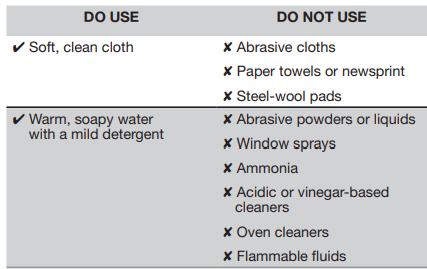
- The water filter compartment is located in the right-hand side of the refrigerator ceiling. Push up on the compartment door to release the catch, then lower the door.
- Align the arrow on the water filter label with the cutout notch in the filter housing and insert the filter into the housing.
- Turn the filter clockwise 90 degrees (1/4 turn), until it locks into the housing.
NOTE:
- If the filter is not correctly locked into the housing, the water dispenser will not operate. Water will not flow from the dispenser.
- While the compartment door is still open, lift the filter up into the compartment. Then, close the filter compartment door completely.
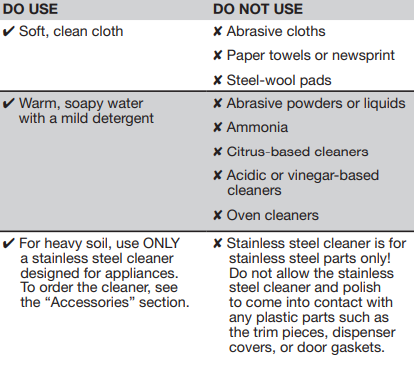
Flush the water system. See “Flushing the Water Filter” in the
Water and Ice Dispensers” section.
IMPORTANT: If you do not flush the water system, you may experience dripping and/or decreased flow from the water dispenser.
The Water Filter Status Light
- Press OPTIONS on the control panel to launch the Options menu.
- Press OPTIONS, under Filter Status, again to display the percentage of filter life remaining (from 99% to 0%). Press ICE/
- WATER, under Back, to return to the Normal screen.
- The water filter status lights will help you know when to change your water filter.
- ORDER FILTER (yellow) - it is almost time to change the water filter. While you are dispensing water, “Order Filter” will blink seven times and sound an alert tone three times.
- REPLACE FILTER (red) - Replace the water filter. While you are dispensing water, “Replace Filter” will blink seven times and an alert tone will sound three times.
Replace the Water Filter
To purchase a replacement water filter, see “Accessories” in the
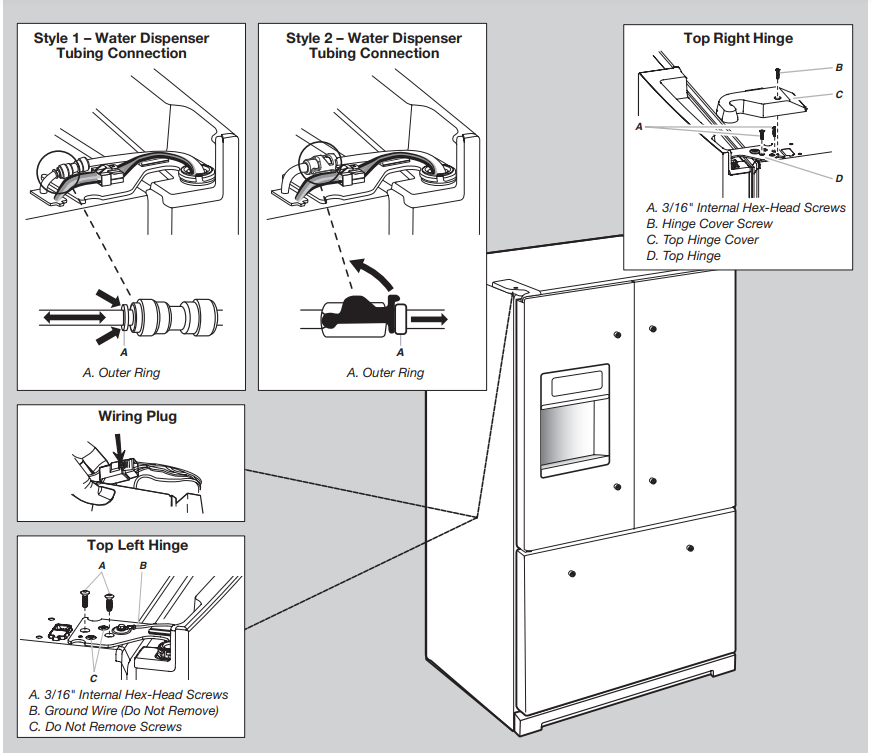
User Guide, Use and Care Guide or User Instructions.
- Replace the disposable water filter when indicated on the water filter status display or at least every 6 months. If water flow to your dispenser or ice maker decreases noticeably, change the water filter sooner.
- Locate the water filter compartment in the right-hand side of the refrigerator ceiling. Push up to release and lower the compartment door.
- Turn the water filter counterclockwise (to the left), and pull it straight out of the compartment.
NOTE:
- There may be some water in the filter. Some spilling may occur. Use a towel to wipe up any spills.
- Install the replacement water filter by following steps 2 through 7 in the “Install the Water Filter” section. nstall Air Filter (on some models)
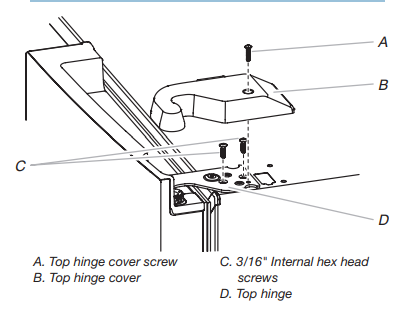
- An air filter is 15 times more powerful than baking soda at reducing common food odors inside the refrigerator.
- On some models, your refrigerator’s accessory packet includes an air filter, which must be installed prior to use.
Installing the Air Filter
- Install the air filter behind the vented door, located on the rear wall near the top of the refrigerator compartment.
- Remove the air filter from its packaging.
- Lift open the vented door.
- Snap the filter into place.
- Replacing the Produce Preserver
- The disposable pouches should be replaced every 6 months or when the status indicator changes completely from white to red.
- To order replacements, contact us. See “Accessories” for information on ordering.
- Remove the used pouches from the produce preserver housing.
- Remove the used status indicator.
- Install the replacement pouches and status indicator using the instructions in the previous sections.
Refrigerator Door(s) and Drawer
Using the Controls
The controls are located above the external dispenser.
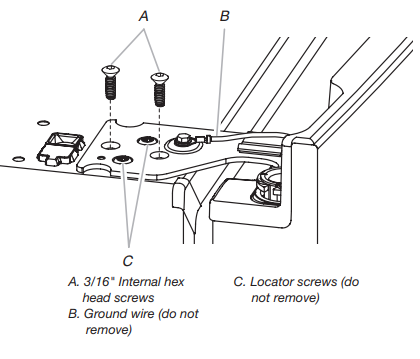
Viewing and Adjusting Temperature Set Points
- For your convenience, your refrigerator and freezer controls are preset at the factory.
- When you first install your refrigerator, make sure that the controls are still set to the recommended set points. The factory recommended set points are 37°F (3°C) for the refrigerator and
- F (-18°C) for the freezer.
IMPORTANT:
- Wait 24 hours before you put food into the refrigerator. If you add food before the refrigerator has cooled completely, your food may spoil.
NOTE:
- Adjusting the set points to a colder than recommended setting will not cool the compartments any faster.
- If the temperature is too warm or too cold in the refrigerator or freezer, first check the air vents to be sure they are not blocked before adjusting the controls.
- The recommended settings should be correct for normal household use. The controls are set correctly when milk or juice is as cold as you like and when ice cream is firm.
NOTE:
- Areas such as a garage, basement or porch, may have higher humidity or extreme temperatures. You may need to adjust the temperature away from the recommended settings to accommodate for these conditions.
- Wait at least 24 hours between adjustments. Recheck the temperatures before other adjustments are made.
View Temperature Set Points
Press and hold TEMP for 3 seconds to activate Temperature mode.
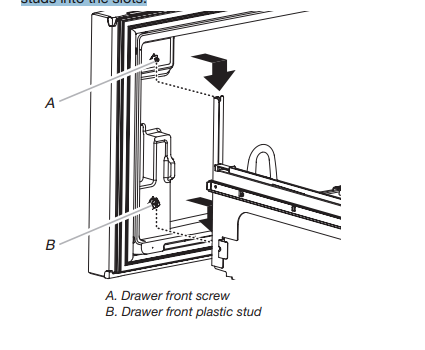
NOTE: To view temperature in degrees Celsius, press the
- LIGHT button, under Units, when adjust mode is activated.
- To return the display setting to Fahrenheit, press the LIGHT button again
Adjust Temperature Set Points
- Refrigerator set point range: 33°F to 45°F (0°C to 7°C).
- Freezer set point range: -5°F to 5°F (-21°C to -15°C).
- After Temperature mode is activated, press TEMP again to Select Zone (Fridge or Freezer). The display will show the temperature set point of the selected compartment, as shown.
- Press LOCK to raise the set point, or press OPTIONS to lower the set point.
- When you have finished viewing (and adjusting if desired) the Fridge zone set point, press TEMP, under Select Zone, to change the display to show the Freezer zone set point. When the zone has been changed, “FREEZER” appears on the display screen.
- Press the LOCK button to raise the set point, or press the OPTIONS button to lower the set point.

Save/Confirm Temperature Settings
- When you have finished adjusting both the refrigerator and freezer set points, press FAST ICE to confirm and to save the settings.
NOTE:
- To exit Temperature mode without saving changes, press the ICE/WATER button under Back at any time, or allow about seconds of inactivity. The temperature mode will turn off automatically and return to the normal screen.
Cooling On/Off
- Your refrigerator and freezer will not cool when cooling is turned off.
- To turn Off cooling, press and hold LOCK and FAST ICE at the same time for 3 seconds. “Cooling Off” will blink seven times and then remain lit as shown.
IMPORTANT:
- To avoid unintentionally locking the dispenser or changing other settings, press both buttons at exactly the same time.
- When cooling is off, the dispenser paddles and all controls except Lock and Fast Ice are disabled.
Fast Ice
- The Fast Ice feature assists with temporary periods of heavy ice use by increasing ice production.
- To turn on the Fast Ice feature, press FAST ICE. When the feature is on, the Fast Ice icon will appear on the display. The
- Fast Ice feature will remain on for 24 hours unless manually turned off.
- To manually turn off the Fast Ice feature, press FAST ICE again. When the feature has been turned off, the Fast Ice icon will disappear from the display.
Filter Status
- Displays the percentage of use remaining in the water filter (from remaining to 0% remaining).
- To access Filter Status, press the OPTIONS button to access the Options menu, then press OPTIONS, under Filter Status, to display the percent of life remaining in the water filter.
ALSO
- The water filter status lights will let you know when to change your water filter.
- ORDER FILTER (Yellow) - Order a replacement water filter.
- REPLACE FILTER (Red) - Replace the water filter. Replacing the disposable water filter will automatically reset the water filter status tracking feature. See “Water Filtration System.”
- NOTE: REPLACE FILTER will remain illuminated if a filter is not installed or installed incorrectly.
Door Ajar Alarm
- The Door Ajar Alarm feature sounds an alarm when the refrigerator door(s) or freezer drawer is open for 5 minutes and cooling is turned on.
- The alarm will repeat every 2 minutes. Close all doors and drawer to turn it off. The feature then is reset and will reactivate when either door is left open again for 5 minutes.
NOTE:
- To mute the audible alarm while keeping the doors open, such as while cleaning the inside of the refrigerator, press any button on the control panel.
- The alarm sound will be temporarily turned off, but the Door Ajar icon will still be displayed on the dispenser control panel.
Disabling Sounds
- To turn off control and dispenser sounds, press and hold ICE/
- WATER and FAST ICE at the same time for 3 seconds. All normal operating tones are disabled. Only alert tones will be audible.
- To turn on control and dispenser sounds, press and hold ICE/
- WATER and FAST ICE at the same time for 3 seconds.
Showroom Mode
- This mode is used only when the refrigerator is on display in a retail store. If you unintentionally turn on Showroom mode, the word “Showroom” will light up on the display.
- Exit Showroom mode by pressing and holding LIGHT and LOCK at the same time for 3 seconds.
Electrical Shock Hazard
- Disconnect power before removing doors.
- Failure to do so can result in death or electrical shock.
- Top Left Hinge Door Removal Top Right Hinge
- Left and Right Bottom Hinge
Freezer drawer models
- Unplug refrigerator or disconnect power.
- Keep the refrigerator door closed until you are ready to lift it free from the cabinet.
- NOTE: Provide additional support for the door while the hinges are being moved. Do not depend on the door gasket magnets to hold the door in place while you are working.
- Remove the parts for the top hinge as shown in Top Hinge graphic. Lift the refrigerator door free from the cabinet.
- Remove the parts for the bottom hinge as shown in Bottom
- Hinge graphic.
Freezer door models
- Unplug refrigerator or disconnect power.
- Keep the freezer door closed until you are ready to lift it free from the cabinet.
- NOTE: Provide additional support for the door while the hinges are being moved. Do not depend on the door gasket magnets to hold the door in place while you are working.
- Remove the parts for the top hinge as shown in Top Hinge graphic. Lift the refrigerator door free from the cabinet.
- Remove the center hinge pin and remove the hinge screws as shown in the Center Hinge graphic. Lift the freezer door free from the cabinet.
- Remove the base grille by grasping the grille firmly with both hands and pulling it toward you.
- Remove the parts for the bottom hinge as shown in Bottom
- Hinge graphic.
Door Closing and Door Alignment
Leveling and Door Closing
Your refrigerator has two front adjustable wheels. See graphic 1.
These are used to level the refrigerator under uneven floor conditions or want the doors to close more easily. Please follow the instructions below:
1. Use a Bubble level to check levelness of floor where the
2. Place the refrigerator into its final location in the kitchen and
3. Fully open both doors. See graphic 1.
4. If your model has water dispensing in the door. please open
5. Pull the base grille toward you from the sides and then from
6. To remove the base grille. twist and pull the right side until this
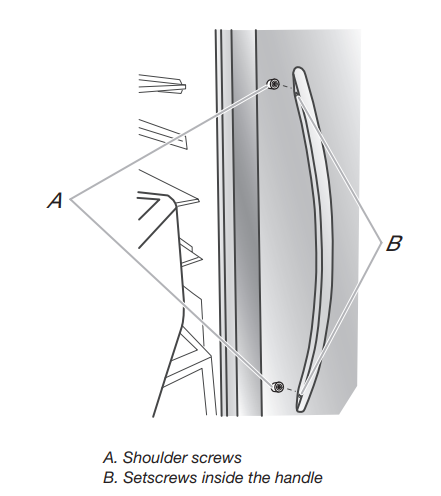
Handle Installation and Removal
PARTS INCLUDED:
- Door handles (2). 1/8" hex key. spare setscrew(s) To Install the Handles: NOTE: The handle mounting setscrews are preinstalled in the handle.
1. Remove the handles. which are packed inside the refrigerator.
NOTE:
- To avoid scratching the finish. place the handles on a towel or other soft surface.
2. Open the freezer door. On the refrigerator door. place the
3. Firmly push the handle toward the door until the handle base
4. While holding the handle. insert the short end of the hex key
5. Using a clockwise motion. tighten the setscrew until it begins
6. Repeat steps 4 and 5 to begin fastening the lower setscrew.
7. Once both setscrews have been partially tightened as outlined
8. Open the refrigerator door and close the freezer door. Repeat
9. Save the hex key and all instructions.

To Remove the Handles:
1. While holding the handle. insert the short end of the hex key
2. Using a counterclockwise motion. loosen the setscrew a
3. Repeat steps 1 and 2 for the upper setscrew. Gently pull the
4. If necessary. use a Phillips screwdriver to remove the shoulder
Location Requirements
- To ensure proper ventilation for your refrigerator. allow for 1/2" (1.27 cm) of space on each side and at the top. Allow for 2" (5.08 cm) of space behind the refrigerator.
- If your refrigerator has an ice maker. allow extra space at the back for the water line connections. When installing your refrigerator next to a fixed wall. leave a 2" (5.08 cm) minimum space on each side (depending on your model) to allow the doors to swing open.
NOTES:
- This refrigerator is intended for use in a location where the temperature ranges from a minimum of 55°F (13°C) to a maximum of 110°F (43°C). The preferred room temperature range for optimum performance. which reduces electricity usage and provides superior cooling. is between 60°F (15°C) and 90°F (32°C). It is recommended that you do not install the refrigerator near a heat source. such as an oven or radiator.
- Normal minimum cabinet cut-out width required for product installation is 36" (91.44 cm). However. if the product is placed against an extended wall and the ability to remove the crisper pans is desired. an additional 18" (45.72 cm) of cabinet width is required. so a total cabinet opening width of 54" (137.16 cm) is recommended.
Electrical Requirements
- Before you move your refrigerator into its final location. it is important to make sure you have the proper electrical connection.
- Recommended Grounding Method A 115 V. 60 Hz. AC only. 15 or 20 A fused. grounded electrical supply is required. It is recommended that a separate circuit serving only your refrigerator be provided. Use an outlet that cannot be turned off by a switch. Do not use an extension cord.
- NOTE: Before performing any type of installation or cleaning. or removing a light bulb. disconnect the refrigerator from the electrical source. When you are finished. reconnect the refrigerator to the electrical source and reset the control (Thermostat. Refrigerator or Freezer Control depending on the model) to the desired setting. See the “Using the Controls” section in the User Instructions. User Guide. or Use and Care Guide.
Using the Controls
Temperature Controls
- For your convenience, your temperature controls are preset at the factory. When you first install your refrigerator, make sure the controls are still set to the recommended set points as shown.
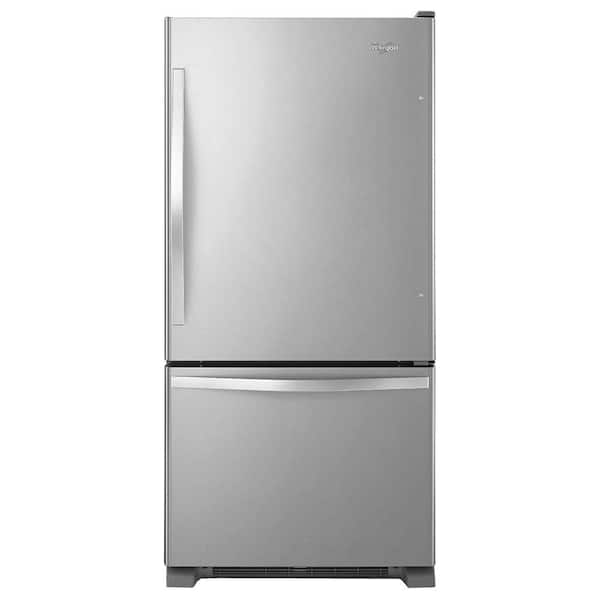
IMPORTANT:
- The recommended settings should be correct for normal household refrigerator use. The controls are set correctly when milk or juice is as cold as you like and when ice cream is firm.
- When the power is on, the temperature display shows the set point temperature of the compartment.
- Wait 24 hours for your refrigerator to cool completely before adding food. If you add food before the refrigerator has cooled completely, your food may spoil.
NOTE:
- Adjusting the refrigerator and freezer temperature controls to a colder than recommended setting will not cool the compartments any faster.
- If the temperature is too warm or too cold in the refrigerator or freezer, first check the air vents to be sure they are not blocked before adjusting the controls.
Humidity Control
- The Humidity Control feature turns on a heater to help reduce moisture on the door hinge seal. Use in humid environments or when you notice moisture on the door hinge seal. The refrigerator uses more energy when Humidity Control is on.
- Press Humidity Control when the environment is warm and more humid, or if you notice moisture on the door hinge seal.
- The indicator light will be lit when humidity control is ON.
- Press Humidity Control to save energy when the environment is less humid.
Temp Alarm
- The Temp Alarm feature provides temperature information in the event of a power outage.
- Power outage: During a power outage, if the temperatures in the refrigerator and freezer compartments exceed normal operating temperatures, the highest temperature reached will be displayed.
Door Alarm
- The Door Alarm feature sounds a chime every few seconds when the refrigerator door has been left open for 5 continuous minutes.
- The chime will sound until the door is closed or Door Alarm is turned off.
- Press the Door Alarm touch pad to turn this feature on or off.
- The indicator light will be lit when the Door Alarm feature is on.
Max Cool
- The Max Cool feature assists with periods of high refrigerator use, full grocery loads, or temporarily warm room temperatures.
- Press Max Cool to set the freezer and refrigerator to the lowest temperature settings. Press Max Cool again to return to the normal refrigerator set point.
NOTE:
- The Max Cool feature will automatically shut off in approximately 12 hours.
Water Dispenser
Water Supply Requirements
- Gather the required tools and parts before starting installation.
- Read and follow the instructions provided with any tools listed here.
Water Pressure
- A cold water supply with water pressure of between 30 and 120 psi (207 and 827 kPa) is required to operate the water dispenser and ice maker. If you have questions about your water pressure. call a licensed. qualified plumber.
- If your refrigerator has a water dispenser: After installation is complete. use the water dispenser to check the water pressure.
- With the water filter removed. dispense 1 cup (237 mL) of water. If 1 cup of water is dispensed in 8 seconds or less. the water pressure to the refrigerator meets the minimum requirement.
- If it takes longer than 8 seconds to dispense 1 cup of water. the water pressure to the refrigerator is lower than recommended. See “Problem Solver” for suggestions.
- Reverse Osmosis Water Supply IMPORTANT: The pressure of the water supply coming out of a reverse osmosis system going to the water inlet valve of the refrigerator needs to be between 30 and 120 psi (207 and 827 kPa).
- If a reverse osmosis water filtration system is connected to your cold water supply. the water pressure to the reverse osmosis system needs to be a minimum of 40 to 60 psi (276 to 414 kPa).
- If the water pressure to the reverse osmosis system is less than 40 to 60 psi (276 to 414 kPa):
- Check to see whether the sediment filter in the reverse osmosis system is blocked. Replace the filter if necessary.
- Allow the storage tank on the reverse osmosis system to refill after heavy usage.
- If your refrigerator has a water filter. it may further reduce the water pressure when used in conjunction with a reverse osmosis system. Remove the water filter. See “Water Filtration System” in the User Instructions. User Guide. or Use & Care Guide.
- If you have questions about your water pressure. call a licensed. qualified plumber.
Connect Water Supply
- Connect to potable water supply only.
- Plumbing shall be installed in accordance with the International Plumbing Code and any local codes and ordinances.
- The gray water tubing on the back of the refrigerator (which is used to connect to the household water line) is a plastic tube. Copper and plastic tubing connections from the household water line to the refrigerator are acceptable. and will help avoid off-taste or odor in your ice or water. Check for leaks.
TOOLS NEEDED:
- Gather the required tools and parts before starting installation.
- Flat-blade screwdriver
- 7⁄16" and 1/2" open-end wrenches or two adjustable wrenches
- 1/4" nut driver
Connect to Water Line
- If you turn the refrigerator on before the water line is connected. turn the ice maker OFF.
Style 1 (Recommended)
1. Unplug refrigerator or disconnect power.
2. Turn OFF main water supply. Turn ON nearest faucet long
3. Use a quarter-turn shutoff valve or the equivalent. served by a
1/2" copper household supply line.
NOTE:
- To allow sufficient water flow to the refrigerator. a minimum 1/2" size copper household supply line is recommended.
4. Now you are ready to connect the copper tubing to the
- Ensure that you have the proper length needed for the job.
- Be sure both ends of the copper tubing are cut square.
- Slip compression sleeve and compression nut onto copper tubing as shown. Insert end of tubing into outlet end squarely as far as it will go. Screw compression nut onto outlet end with adjustable wrench. Do not overtighten.
5. Place the free end of the tubing into a container or sink. and
- Do not use with water that is microbiologically unsafe or of unknown quality without adequate disinfection before or after the system. Systems certified for cyst reduction may be used on disinfected waters that may contain filterable cysts
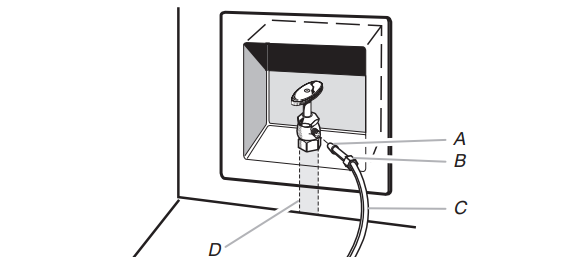
A. Bulb B. Nut
C. Copper tubing (to refrigerator)
D. Household supply line (½" minimum)
A. Compression sleeve B. Compression nut
6. Bend the copper tubing to meet the water line inlet. which
Water Filtration System
Make sure it is a cold water pipe.
- Horizontal pipe will work. but drill on the top side of the pipe. not the bottom. This will help keep water away from the drill and normal sediment from collecting in the valve.
- Determine the length of copper tubing you need. Measure
- Using a cordless drill. drill a 1⁄4" (6.35 mm) hole in the cold
- Fasten the shutoff valve to the cold water pipe with the pipe
- Slip the compression sleeve and compression nut on
- Place the free end of the tubing in a container or sink. and
Connect to Refrigerator
1.Style 1 1. Unplug refrigerator or disconnect power.
2. Remove and discard the short. black plastic part from the end
3. Thread the nut onto the end of the tubing. Tighten the nut by
4. Install the water supply tube clamp around the water supply
5. Turn shutoff valve ON.
6. Check for leaks. Tighten any connections (including
Style 2
1. Unplug refrigerator or disconnect power.
2. Remove and discard the plastic part that is attached to the
3. Attach the copper tube to the valve inlet using a compression
4. Use the tube clamp on the back of the refrigerator to secure
5. Turn shutoff valve ON.
6. Check for leaks. Tighten any connections (including
7. On some models. the ice maker is equipped with a built-in
Style 3
1. Unplug refrigerator or disconnect power.
2. Remove and discard the black nylon plug from the gray water
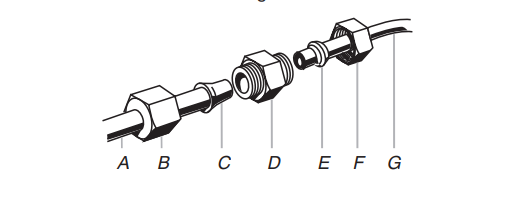
A. Cold water pipe B. Pipe clamp C. Copper tubing D. Compression nut
E. Compression sleeve F. Shut-off valve G. Packing nut
3. If the gray water tube supplied with the refrigerator is not
4. Turn shutoff valve ON.
5. Check for leaks. Tighten any nuts or connections (including
Complete the Installation
1. Plug into a grounded 3 prong outlet.
2. Flush the water system. See “Water and Ice Dispensers” in
NOTE:
- Allow 24 hours to produce the first batch of ice. Allow 72 hours to completely fill ice container.
REFRIGERATOR USE
Flush the Water System
- Air in the water dispensing system can cause the water dispenser to drip. After connecting the refrigerator to a water source or replacing the water filter, flush the water system.
- Flushing the water dispensing system forces air from the water line and filter and prepares the water filter for use. Additional flushing may be required in some households.
NOTE: As air is cleared from the system, water may spurt out of the dispenser.
- Using a sturdy container, depress and hold the water dispenser paddle for 5 seconds.
- Release the dispenser paddle for 5 seconds. Repeat steps 1 and 2 until water begins to flow.
- Once water begins to flow, continue depressing and releasing the dispenser pad (5 seconds on, 5 seconds off) until a total of 3 gal. (12 L) has been dispensed.
Dispensing
Press ICE/WATER to toggle through the following choices in a continuous loop:
Water (default) - Dispenses water
Cubed - Dispenses cubed ice
Crushed - Dispenses crushed ice
NOTES:
The word “ICE” appears on the display screen when either crushed or cubed ice is selected.
For crushed ice, cubes are crushed before being dispensed. This may cause a slight delay when dispensing crushed ice. Noise from the ice crusher is normal, and pieces of ice may vary in size.
When changing from crushed to cubed, a few ounces of crushed ice will be dispensed along with the first cubes.
The Water Dispenser
IMPORTANT:
- Dispense at least 1 qt (1 L) of water every week to maintain a fresh supply.
- If the flow of water from the dispenser decreases, it could be caused by low water pressure.
- With the water filter removed, dispense 1 cup (237 mL) of water. If 1 cup (237 mL) of water is dispensed in 8 seconds or less, the water pressure to the refrigerator meets the minimum requirement.
- If it takes longer than 8 seconds to dispense 1 cup mL) of water, the water pressure to the refrigerator is lower than recommended. See “Water Supply
- Requirements” and “Problem Solver” or “Troubleshooting” for suggestions.
To Dispense Water:
- Select water.
- Press a sturdy glass against the dispenser paddle.
NOTE: While dispensing water and for 3 seconds after dispensing has stopped, the digital display will show how much water has been dispensed.
- Remove the glass to stop dispensing.
The Ice Dispenser
IMPORTANT:
- If the ice cubes are hollow or have an irregular shape, it could be because of low water pressure. See “Water Supply
- Requirements.”
- Ice travels from the ice storage bin through the dispenser chute to the dispenser. To turn off the ice maker, see “Ice
- Maker and Storage Bin.”
To Clean the Ice Dispenser Chute:
- Humidity causes ice to naturally clump together. Ice particles can build up until the ice dispenser chute becomes blocked.
- If ice is not dispensed regularly, it may be necessary to empty the ice storage bin and clean the ice delivery chute, the ice storage bin and the area beneath the storage bin every 2 weeks.
- Remove the ice clogging the storage bin and delivery chute, using a plastic utensil if necessary.
- Clean the ice delivery chute and the bottom of the ice storage bin using a warm, damp cloth, then dry thoroughly
To Dispense Ice:
- Select the desired type of ice. To switch between cubed ice and crushed ice, press ICE/WATER.
- Press a sturdy glass against the dispenser paddle. Hold the glass close to the dispenser opening so ice does not fall outside of the glass.
IMPORTANT:
- You do not need to apply a lot of pressure to the paddle to activate the ice dispenser. Pressing hard will not make the ice dispense faster or in greater quantities.
- Remove the glass to stop dispensing.
NOTE:
- Ice may continue to dispense for several seconds after removing the glass from the dispenser paddle. The dispenser may continue to make noise for a few seconds after dispensing.
The Dispenser Light
- When you use the dispenser, the light will automatically turn on.
- To turn on the light when you are not dispensing:
- Press LIGHT to toggle through the following choices in a continuous loop:
- OFF (default) - The dispenser light is off
- ON - The dispenser light remains on at 100% brightness
- DIM - The dispenser light remains on at 50% brightness
- The dispenser lights are LEDs that cannot be changed. If it appears that your dispenser lights are not working, see
The Dispenser Lock
- The dispenser can be turned off for easy cleaning or to avoid unintentional dispensing by small children and pets.
NOTE:
- The lock feature does not shut off power to the refrigerator, to the ice maker, or to the dispenser light. It simply deactivates the controls and dispenser paddles. To turn off the ice maker, see “Ice Maker and Storage Bin.”
- Press and hold LOCK for 3 seconds to lock the dispenser.
- Press and hold LOCK a second time to unlock the dispenser.
- The display screen indicates when the dispenser is locked.
To remove and replace a shelf/shelf frame:
- Remove the shelf/frame by tilting it up at the front and lifting it out of the shelf supports.
- Replace the shelf/frame by guiding the rear shelf hooks into the shelf supports. Tilt the front of the shelf up until rear shelf hooks drop into the shelf supports.
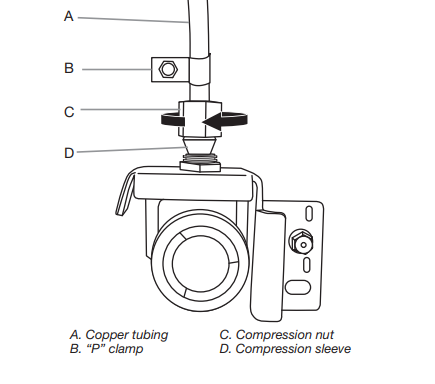
- Lower the front of the shelf and make sure that the shelf is in position.
- To retract and extend the front section of the shelf:
- To retract the front-section of the shelf, slightly lift up on the front edge and push the adjustable portion of the shelf back toward the rear of the refrigerator.
- Extend the front of the shelf by pulling the retracted portion of the shelf outward until it is fully extended.
Crisper Humidity Control
- You can control the amount of humidity in the moisture-sealed crisper. Adjust the control to any setting between LOW (open) and HIGH (closed).
- LOW - Move control to the far left-hand side to allow moist air out of the crisper for best storage of fruits and vegetables with skins.
- Fruit: Wash, let dry and store in refrigerator in plastic bag or crisper. Do not wash or hull berries until they are ready to use.
- Sort and keep berries in original container in crisper, or store in a loosely closed paper bag on a refrigerator shelf.
- Vegetables with skins: Place in plastic bags or plastic container and store in crisper.
- HIGH - Move control to the far right-hand side to keep moist air in the crisper for best storage of fresh, leafy vegetables.
- Leafy vegetables: Wash in cold water, drain and trim or tear off bruised and discolored areas. Place in plastic bag or plastic container and store in crisper.
Temperature-Controlled Drawer
IMPORTANT:
- This control sets the temperature for only this drawer. It does not set the temperature for, or turn off cooling to the refrigerator or freezer compartments.
- The full-width, temperature-controlled drawer can be used to store large deli trays, fresh meat, beverages or other items that you want to store at an optimum temperature.
- Depending on your model, you will have either an Electronic
- Control or a Manual Control. Use the directions specific to your model.
NOTE: Do not place leafy vegetables in the temperature controlled drawer. The colder temperatures could damage leafy produce.
Cleaning
- Both the refrigerator and freezer sections defrost automatically.
- However. clean both sections about once a month to avoid buildup of odors. Wipe up spills immediately.
Exterior Cleaning
- Please see the exterior cleaning information specific to your model.
Style 1: Smooth Door
IMPORTANT: Damage to smooth finish due to improper use of cleaning products or using non-recommended cleaning products is not covered under the warranty. Sharp or blunt instruments will mar the finish.
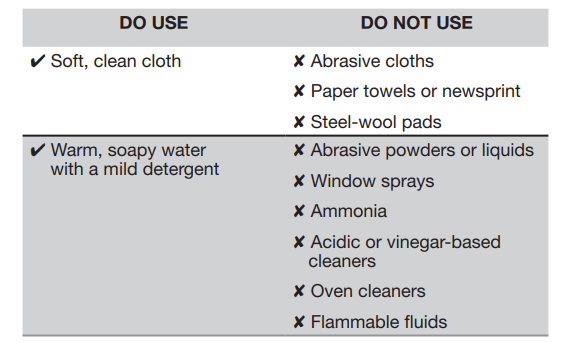
NOTES:
- If unintentional contact does occur, clean plastic part with a sponge and mild detergent in warm water. Dry thoroughly with a soft cloth.
- Just because a cleaner is a liquid does not mean it is nonabrasive. Many liquid cleansers formulated to be gentle on tile and smooth surfaces still damage stainless stee
- Citric acid permanently discolors stainless steel.
Style 2: Stainless Steel
IMPORTANT:
- Damage to stainless steel finish due to improper use of cleaning products, or using non-recommended cleaning products, is not covered under the warranty.
Interior Cleaning
- Unplug refrigerator or disconnect power.
- Hand wash, rinse, and dry removable parts and interior surfaces thoroughly. Use a clean sponge or soft cloth and a mild detergent in warm water.
NOTE:
- Do not use abrasive or harsh cleaners such as window sprays, scouring cleansers, flammable fluids, cleaning waxes, concentrated detergents, bleaches, or cleansers containing petroleum products on plastic parts, interior and door liners, or gaskets.
- Plug in refrigerator or reconnect power.
Condenser Cleaning
- There is no need for routine condenser cleaning in normal home operating environments. If the environment is particularly greasy or dusty or there is significant pet traffic in the home, the condenser should be cleaned every 6 months to ensure maximum efficiency.
- If you need to clean the condenser, please call for service.
- Unplug refrigerator or disconnect power.
Remove the base grille.
- Use a vacuum cleaner with a soft brush to clean the grille, the open areas behind the grille and the front surface area of the condenser.
- Replace the base grille when finished.
- Plug in refrigerator or reconnect power.
To Clean Your Refrigerator:
1. Unplug refrigerator or disconnect power.
2. Hand wash, rinse, and dry removable parts and interior surfaces thoroughly. Use a clean sponge or soft cloth and a mild detergent in warm water.
3. Clean the exterior surfaces. Painted metal: Wash painted metal exteriors with a clean, soft cloth or sponge and a mild detergent in warm water. Rinse surfaces with clean, warm water and dry immediately to avoid water spots. Stainless steel: Wash stainless steel surfaces with a clean, soft cloth or sponge and a mild detergent in warm water. Rinse surfaces with clean, warm water and dry immediately to avoid water spots.
4. There is no need for routine condenser cleaning in normal home operating environments. If the environment is particularly greasy or dusty, or there is significant pet traffic in the home, the condenser should be cleaned every 2 to 3 months to ensure maximum efficiency.
NOTE:
- Do not use abrasive or harsh cleaners such as window sprays, scouring cleansers, flammable fluids, muriatic acid, cleaning waxes, concentrated detergents, bleaches or cleansers containing petroleum products on exterior surfaces (doors and cabinet), plastic parts, interior and door liners or gaskets.
- Do not use paper towels, scouring pads, or other harsh cleaning tools.
IMPORTANT:
- Because air circulates between both sections. any odors formed in one section will transfer to the other. You must thoroughly clean both sections to eliminate odors. To avoid odor transfer and drying out of food. wrap or cover foods tightly.
Remove the base grille.
- See the “Door Removal” instructions. either in the User Instructions or the Installation Instructions and Owner’s Manual. or in the separate instruction sheet provided with your refrigerator.
- Use a vacuum cleaner with a soft brush to clean the grille. the open areas behind the grille and the front surface area of the condenser.
- Replace the base grille when finished.
- Plug in refrigerator or reconnect power.
LED Bulbs
- Incandescent Bulbs
- Or a combination of the above.
- If a Sealed LED Module(s) do not illuminate when the refrigerator and/or freezer door is opened. call whirlpool service for technical support. (See User Guide).
- See "Warranty" for contact information.
- IF a LED Bulb or incandescent bulb does not turn ON when the refrigerator and/or freezer door is opened. replace with a bulb recommended by Whirlpool and following the next procedure:
1. Unplug refrigerator or disconnect power.
2. Remove light cover (in some models)
NOTE:
- To clean the light cover. follow the instructions in REFRIGERATOR CARE section.
3. Remove light bulb and replace with one of the same size.
4. Reinstall light cover (in some models).
5. Plug in refrigerator or reconnect power.
NOTE: Not all appliance bulbs will fit your refrigerator. Be sure to replace the bulb with one of the same size and shape. On some models. the interior lights require a 40 W bulb max.
Vacation and Moving Care
1. Use up any perishables and freeze other items.
2. If your refrigerator has an automatic ice maker and is
3. If you have an automatic ice maker. turn off the ice maker.
NOTE:
- Depending on your model. raise the wire shutoff arm to OFF (up) position or press the switch to OFF (right).
4. Empty the ice bin.
FREEZER SHELF
To Remove and Replace the Bottom Shelf:
1. Lift up the front and back of the shelf. and remove from the
2. Replace the shelf aligning the rods with the cabinet ribs.
- Apply a little pressure on the shelf to attach the rods to the ribs of the cabinet.
- To Remove and Replace the Mid and Top Shelf: 1. With your hand. push the shelf from bottom to top until it is

TROUBLESHOOTING .
The refrigerator will not operate
- Check electrical supply
- Check controls
- New installation
- Refrigerator control is in
- Plug the power cord into a grounded 3 prong outlet
- Make sure there is power to the outlet. Plug in a lamp to see if the outlet is working
- Reset a tripped circuit breaker. Replace any blown fuses.
- Allow 24 hours following installation for the refrigerator to cool completely. NOTE: Adjusting the temperature controls to the coldest setting will not cool either compartment more quickly
- If the refrigerator is in Showroom mode, cooling is turned off and “Showroom” will be illuminated on the control panel. See “Using the Control(s)” for more information.
The motor seems to run too much
- High efficiency compressor and fans
- The room or outdoor temperature is hot.
- A large amount of warm food has been recently added.
- The door(s) are opened too frequently or for too long
- The refrigerator door or freezer drawer is ajar.
- The refrigerator control is set too cold
- The door or drawer gasket is dirty, worn, or cracked.
- Larger, more efficient refrigerators run longer at lower, more energy efficient speeds.
- It is normal for the refrigerator to work longer under these conditions. For optimum performance, place the refrigerator in an indoor, temperature controlled environment. See “Location Requirements.”
- Warm food will cause the refrigerator to run longer until the air cools to the desired temperature.
- Warm air entering the refrigerator causes it to run more. Open the door less often
- Make sure the refrigerator is level. See “Refrigerator Leveling, Door Closing and Alignment.” Keep food and containers from blocking the door.
- Adjust the refrigerator control to a less cold setting until the refrigerator temperature is as desired.
- Clean or change the gasket. Leaks in the door seal will cause the refrigerator to run longer in order to maintain desired temperatures.
The lights do not work
- Your refrigerator is equipped with LED lighting which does not need to be replaced.
- The dispenser light is set to OFF.
- Doors have been open longer than 10 minutes.
- If there is power to the refrigerator and the lights do not illuminate when a door or drawer is opened, call for service or assistance.
- On some models, the dispenser light will operate only when a dispenser paddle is pressed. If you want the dispenser light to stay on continuously, see “Water and Ice Dispensers.
- Close the doors and drawer to reset, and open to resume lighted task.
Pantry Temperature Control not lit/ unresponsive
- The refrigerator is in Cooling Off mode.
- The refrigerator controls’ initialization process did not complete successfully
- Exit Cooling Off mode. See “Using the Control(s).”
- Unplug the refrigerator, wait 5 seconds. Plug in the refrigerator, and wait 30 seconds before opening any of the refrigerator doors or touching the control panel.
Refrigerator will not operate
- Not connected to an electrical supply - Plug the power cord into a grounded 3 prong outlet. Do not use an extension cord.
- No power to the electrical outlet - Plug in a lamp to see if the outlet is working.
- Household fuse has blown or circuit breaker has tripped - Replace the fuse or reset the circuit breaker. If the problem continues, contact a licensed electrician.
New installation
- Following installation, allow 24 hours for the refrigerator and freezer to cool completely. NOTE: Adjusting the temperature control(s) to the coldest setting will not cool either compartment (refrigerator or freezer) more quickly.
Motor seems to run too much
- Your new refrigerator has an energy-efficient motor
- The refrigerator may run longer than you’re used to, because the compressor and fans operate at lower speeds that are more energyefficient. This is normal.
NOTE:
- Your refrigerator may run even longer if the room is warm, a large load of food is added, the doors are opened often, or if a door has been left open.
Refrigerator seems noisy
- The compressor in your new refrigerator regulates temperature more efficiently and uses less energy than older models. During various stages of operation, you may hear normal operating sounds that are unfamiliar. The following noises are normal:
- Buzzing/Clicking - Heard when the water valve opens and closes to dispense water or fill the ice maker. If the refrigerator is connected to a water line, this is normal. If the refrigerator is not connected to a water line, turn off the ice maker.
- Cracking/Crashing - Heard when ice is ejected from the ice maker mold.
- Popping - Heard when the inside walls contract/expand, especially during initial cooldown.
- Pulsating/Whirring - Heard when the fans/compressor adjust to optimize performance during normal operation.
- Rattling - Heard when water passes through the water line, or due to the flow of refrigerant. Rattling may also come from items placed on top of the refrigerator.
- Water running or gurgling - Heard when ice melts during the defrost cycle and water runs into the drain pan. Sizzling - Heard when water drips onto the heater during the defrost cycle.
Temperature is too warm
- New installation - Following installation, allow 24 hours for the refrigerator and freezer to cool completely.
NOTE:
- Adjusting the temperature control(s) to the coldest setting will not cool either compartment (refrigerator or freezer) more quickly.
- Doors are opened often or not closed completely - This allows warm air to enter the refrigerator. Minimize door openings, keep the doors fully closed, and make sure both doors are properly sealed.
- Air vents are blocked - Remove items that are immediately in front of the vents.
- Large amount of warm food recently added - Allow several hours for the refrigerator to return to its normal temperature.
- Controls are not set correctly for the surrounding conditions - Adjust the controls to a colder setting. Check the temperature again in 24 hours.
Temperature is too cold
- Controls are not set correctly for the surrounding conditions - Adjust the controls to a warmer setting. Check the temperature again in 24 hours.
- Top refrigerator shelf is colder than lower shelves - On some models, air from the freezer enters the refrigerator compartment through vents near the top refrigerator shelf. As a result, the top shelf can be slightly colder than lower shelves.
- Air vents are blocked - Remove items that are immediately in front of the vents.
- Interior moisture buildup NOTE: Some moisture buildup is normal. Clean with a soft dry cloth.
- Room is humid - A humid environment contributes to moisture buildup. Use the refrigerator only in an indoor location, with as little humidity as possible.
- Doors are opened often or not closed completely - This allows humid air to enter the refrigerator. Minimize door openings, keep the doors fully closed, and make sure both doors are properly sealed.
Interior lights do not work
- Doors have been open for an extended period of time - Close the doors to reset the lights.
- Light bulb is loose in the socket or has burned out - On models with incandescent interior light bulbs, tighten or replace the bulb. See the “Lights” section.
NOTE:
- On models with mini LED lights, call for assistance or service if the interior lights do not illuminate when either door is opened. See the Warranty in the User Instructions or User Guide for contact information.
Dispenser lights do not work on some models)
- Dispenser light is turned off - On some models, if the dispenser light is set to OFF, the light will turn on only when a dispenser pad/lever is pressed. If you want the dispenser light to stay on continuously, select a different setting. See “Water and Ice Dispensers” in the User Instructions or User Guide.
- Dispenser light is set to AUTO or NIGHT LIGHT - On some models, if the dispenser light is set to AUTO or NIGHT LIGHT, make sure the dispenser light sensor is not blocked. See “Water and
- Ice Dispensers” in the User Instructions or User Guide.
NOTE:
- On models with mini LED lights, call for assistance or service if the dispenser lights do not
The ice maker is not producing ice or not enough ice
- Refrigerator connected to a water supply and the supply shutoff valve turned on? Connect refrigerator to water supply and turn water shutoff valve fully open.
- Kink in the water source line? A kink in the line can reduce water flow. Straighten the water source line.
- Ice maker turned on? Make sure wire shutoff arm or switch (depending on model) is in the ON position.
- New installation? Wait 24 hours after ice maker installation for ice production to begin. Wait 72 hours for full ice production.
- Freezer door closed completely? Firmly close the freezer compartment door. If the freezer compartment door will not close all the way, see “The doors will not close completely,” earlier in this section.
The water dispenser will not operate properly
- Refrigerator connected to a water supply and the supply shutoff valve turned on? Connect refrigerator to water supply and turn water shutoff valve fully open.
- Kink in the water source line? Straighten the water source line.
- New installation? Flush and fill the water system. See “Water Dispenser.”
- Is the water pressure at least 35 psi (241 kPa)? The water pressure to the home determines the flow from the dispenser. See “Water Supply Requirements.”
- Water filter installed on the refrigerator? Remove filter and operate dispenser. If water flow increases, the filter may be clogged or incorrectly installed. Replace filter or reinstall it correctly.
Cleaning your refrigerator
- Unplug refrigerator or disconnect power.
- Remove all removable parts from inside. such as shelves. crispers. etc.
- Hand wash. rinse. and dry removable parts and interior surfaces thoroughly.
- Use a clean sponge or soft cloth and a mild detergent in warm water. Do not use abrasive or harsh cleaners such as window sprays. scouring cleansers. flammable fluids. cleaning waxes. concentrated detergents. bleaches or cleansers containing petroleum products on plastic parts. interior and door liners or gaskets.
- Do not use paper towels. scouring pads. or other harsh cleaning tools. These can scratch or damage materials.
- Wash stainless steel and painted metal exteriors with a clean sponge or soft cloth and a mild detergent in warm water. Do not use abrasive or harsh cleaners.
- Dry thoroughly with a soft cloth. For additional protection against damage to painted metal exteriors. apply appliance wax (or auto paste wax) with a clean. soft cloth. Do not wax plastic parts.
- NOTE: To keep your Stainless Steel refrigerator looking like new and to remove minor scuffs or marks. it is suggested that you use the manufacturer's approved Stainless Steel Cleaner & Polish.
- IMPORTANT: This cleaner is for Stainless Steel parts only!
- Do not allow the Stainless Steel Cleaner & Polish to come into contact with any plastic parts such as the trim pieces. dispenser covers or door gaskets. If accidental contact does occur. clean plastic part with a sponge and mild detergent in warm water. Dry thoroughly with a soft cloth. To order the cleaner. see the "Accessories" section.
- Clean the condenser coils regularly. Coils may need to be cleaned as often as every other month. This may help save energy. Pull refrigerator out away from the wall (see the "Unpacking" section).
Off-taste, odor or gray color inthe ice
- New plumbing connections? New plumbing connections can cause discolored or off-flavored ice.
- Ice stored too long? Discard ice. Wash ice bin. Allow hours for ice maker to make new ice.
- Odor transfer from food? Use airtight, moisture proof packaging to store food.
- Are there minerals (such as sulfur) in the water? A water filter may need to be installed to remove the minerals.
- Water filter installed on the refrigerator? Gray or dark discoloration in ice indicates that the water filtration system needs additional flushing. Flush the water system before using a new water filter. Replace water filter when indicated. See
- Water Filtration System."
Water from the dispenser is warm
NOTE: Water from the dispenser is only chilled to 50°F (10°C).
- New installation? Allow 24 hours after installation for the water supply to cool completely.
- Recently dispensed large amount of water? Allow 24 hours for water supply to cool completely.
- Water not been recently dispensed? The first glass of water may not be cool. Discard the first glass of water.
- Refrigerator connected to a cold water pipe? Make sure the refrigerator is connected to a cold water pipe. See "Water
- Supply Requirements."
Vacuum coils when they are dusty or dirty.
- Roll refrigerator back into place. Make sure to leave 1 in. (2.5 cm) between the cabinet back and the wall.
- Check to see that the refrigerator is level.
- Plug in refrigerator or reconnect power.
NOTE:
- Not all appliance bulbs will fit your refrigerator.
- Be sure to replace the bulb with one of the same size. shape. and wattage.
ITEMS WHIRLPOOL WILL NOT PAY FOR
1. Service calls to correct the installation of your major appliance, to instruct you how to use your major appliance, to replace or repair house fuses or to correct house wiring or plumbing.
2. Service calls to repair or replace appliance light bulbs, air filters or water filters. Those consumable parts are excluded from warranty coverage.
3. Repairs when your major appliance is used for other than normal, single-family household use. 4. Damage resulting from accident, alteration, misuse, abuse, fire, flood, acts of God, improper installation, installation not in accordance with electrical or plumbing codes, or use of products not approved by Whirlpool. 5. Any food loss due to refrigerator or freezer product failures.
6. Replacement parts or repair labor costs for units operated outside the United States or Canada.
7. Pickup and delivery. This major appliance is designed to be repaired in the home.
8. Repairs to parts or systems resulting from unauthorized modifications made to the appliance.
9. Expenses for travel and transportation for product service in remote locations.
10. The removal and reinstallation of your appliance if it is installed in an inaccessible location or is not installed in accordance with published installation instructions.
11. Replacement parts or repair labor costs when the major appliance is used in a country other than the country in which it was
See other models: 30S6-30LP 30T6-30LP 40T6-34LP 40S6-40LP 50T6-40LP
